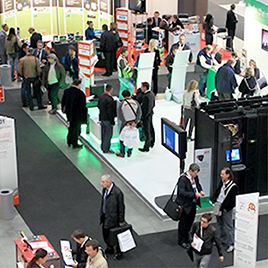
Brian Bloom | February 26, 2024
More than 70,000 people will descend on Las Vegas this week to attend the 2024 NAHB International Builders’ Show (IBS) – the world’s largest gathering for residential building professionals in North America – to see what new products and solutions hundreds of exhibitors have to offer.
Will your brand be among them?
How trade shows can unlock opportunities for your brand
Trade shows like IBS are a vital investment for brands, offering a plethora of benefits that other marketing and sales efforts find hard to match. Show attendees are often managers, buyers, and decision-makers seeking answers to specific problems that your brand can solve. Trade shows, in short, are fertile ground for finding new prospects and meeting with customers.
Attendance continues to grow, as well. In 2023, an estimated 12.7 million people attended trade shows and conferences in the U.S., and the industry in general reached $11.8 billion, a 16% increase over the previous year, according to Statista.
Trade shows offer an ideal platform to showcase new products. Hands-on demonstrations provide prospects with an opportunity to see your solution in action and, when appropriate, try it out for themselves. That can make all the difference, considering most attendees – 92% according to Trade Show Labs – are there to see new products and product demonstrations.
If you want to reap the rewards of exhibiting at a trade show – increased visibility and brand exposure, lead generation and networking, successful product launches, enhanced industry authoring, and more – you need a strategy that will ensure your time and investment is worthwhile.
Step 1. Before the show
Every trade show strategy should begin with a clear goal and end with a stunning post-show evaluation.
Set a clear goal
Why are you exhibiting? If you’re new, you might attend strictly for brand exposure and networking. If your organization is well-established in the industry, you are likely launching a new product or driving lead generation.
Once you know why you’re exhibiting, give yourself a target to aim for and put some numbers behind it: specific number of leads, sales, partnerships, and so forth.
Build the best budget for success
Allocate resources for trade show booth space, design, travel, and marketing, and then stick to your budget. If you’re a challenger brand eyeing the next stage in your overall journey, remember that bigger trade show displays with flashier designs don’t necessarily equate to success. Work with what you have, get creative, and execute flawlessly.
Finalize your messaging
Craft a compelling message that resonates with attendees. You should know what your prospects and customers’ pain points are and how you solve them. Be concise, succinct, and creative. Then ensure your brand messaging is delivered consistently by all team members, whether they’re working the booth, at an evening event, or riding an elevator with a potential customer.
Tell attendees you’ll be there
Promote your presence before the event through social media, email campaigns, targeted invitations, and more. Schedule meetings with potential clients in advance, when possible. If you’re launching a new product, reach out to trade media and set up a time to tell your story.
Step 2: At the Show
Next, put your strategy in action.
Use reminders to ensure prospects won’t miss a meeting
Just because you have a meeting, doesn’t mean you’ll keep it. Send personalized reminders – texts, emails, social media messages – to show how excited you are to meet your prospect. This personalized touch can reduce the chance of no-shows or cancellations.
Gather the most lead information you can
As you meet with customers, prospects, and media, have a system in place to capture as much detailed information as possible. Recalling personal details or anecdotes, details about your conversations, and any specific questions asked is critical to ensuring personalized follow-up.
Leverage social media to spread your message
Use social media to share pertinent booth activity information, breaking news, and other information. This reinforces your brand messaging and reminds attendees to visit your booth.
Include the hashtag #IBS2024 in your posts and make sure your organization is active on the IBS 2024 social media platforms, including LinkedIn, Facebook, Instagram, and X.
Step 3: Post Show
Continue with your strategy after the show closes.
Follow-up with prospects and customers
Once you return – and are likely exhausted – be sure not to end there. Continue engaging prospects and customers by highlighting the show on social media and, most importantly, don’t neglect following up with your sales leads. Use your notes to recall details from conversations to personalize responses to show you are serious about securing their business.
And do so in a timely manner
Striking while excitement is high, and memories are fresh is imperative. Prospects and customers prefer hearing from sales representatives soon after a show – within 28 days according to a MECLABS test. Even if your prospect doesn’t convert, by connecting early, you lay the groundwork for future sales.
By thoroughly planning for each stage, your trade show experience will be a success.
And remember, Falls & Co. is always here to help you through any step in your trade show strategy. Want to chat? Drop us a line.


